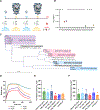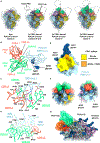Isolation and escape mapping of broadly neutralizing antibodies against emerging delta-coronaviruses
- PMID: 39488210
- PMCID: PMC12279085
- DOI: 10.1016/j.immuni.2024.10.001
Isolation and escape mapping of broadly neutralizing antibodies against emerging delta-coronaviruses
Abstract
Porcine delta-coronavirus (PDCoV) spillovers were recently detected in febrile children, underscoring the recurrent zoonoses of divergent CoVs. To date, no vaccines or specific therapeutics are approved for use in humans against PDCoV. To prepare for possible future PDCoV epidemics, we isolated PDCoV spike (S)-directed monoclonal antibodies (mAbs) from humanized mice and found that two, designated PD33 and PD41, broadly neutralized a panel of PDCoV variants. Cryoelectron microscopy (cryo-EM) structures of PD33 and PD41 in complex with the S receptor-binding domain (RBD) and ectodomain trimer revealed the epitopes recognized by these mAbs, rationalizing their broad inhibitory activity. We show that both mAbs competitively interfere with host aminopeptidase N binding to neutralize PDCoV and used deep-mutational scanning epitope mapping to associate RBD antigenic sites with mAb-mediated neutralization potency. Our results indicate a PD33-PD41 mAb cocktail may heighten the barrier to escape. PD33 and PD41 are candidates for clinical advancement against future PDCoV outbreaks.
Keywords: PDCoV; cryo-EM structures; deep mutational scanning; neutralizing antibodies; porcine deltacoronavirus; spike glycoprotein; zoonosis.
Copyright © 2024 The Author(s). Published by Elsevier Inc. All rights reserved.
Conflict of interest statement
Declaration of interests D.V. is named as inventor on patents for CoV nanoparticle vaccines filed by the University of Washington. D.C., L.P., A.D., K.C., C.S., A.B., and F.B. are employees of Vir Biotechnology and may hold shares in Vir Biotechnology.
Figures






Update of
-
Broadly neutralizing antibodies against emerging delta-coronaviruses.bioRxiv [Preprint]. 2024 Apr 1:2024.03.27.586411. doi: 10.1101/2024.03.27.586411. bioRxiv. 2024. Update in: Immunity. 2024 Dec 10;57(12):2914-2927.e7. doi: 10.1016/j.immuni.2024.10.001. PMID: 38617231 Free PMC article. Updated. Preprint.
References
-
- Hamre D, and Procknow JJ (1966). A new virus isolated from the human respiratory tract. Proc. Soc. Exp. Biol. Med. 121, 190–193. - PubMed
-
- Drosten C, Gunther S, Preiser W, van der Werf S, Brodt HR, Becker S, Rabenau H, Panning M, Kolesnikova L, Fouchier RA, et al. (2003). Identification of a novel coronavirus in patients with severe acute respiratory syndrome. N. Engl. J. Med. 348, 1967–1976. - PubMed
Publication types
MeSH terms
Substances
Grants and funding
LinkOut - more resources
Full Text Sources

